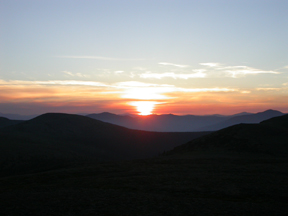Earth's climate has and will continue to change
Earth’s climate has and will continue to change
Submitted by Ned Rozell
Phone: 907-474-7468
12/19/07

My memories of growing up in New York include a blanket of snow on the ground from about Thanksgiving until March. After I moved to Alaska a few decades ago, the snow Back East seemed less dependable on each winter visit, with rain often wiping it out. I thought maybe I had noticed a change, but memories are the most unreliable of data sets.
Last week, at a poster session at the American Geophysical Union’s fall meeting, which attracted about 15,000 scientists to San Francisco, a scientist chatted about "a region-wide winter warming trend" for New England. She had checked out regional weather records from 1965 to 2005 (which also happens to be the middle 40 years of my life).
"People who have lived in New England a long time always seem to tell you that it used to snow more and that it’s warmer now," said Liz Burakowski of the Climate Change Research Center at the University of New Hampshire at Durham. "Maybe this study shows that anecdotal evidence can sometimes be right,"
She tallied up results from 109 temperature stations in New England and has found that since 1965, the winter maximum temperature in the region has increased about .43 degrees Celsius per decade, and the winter minimum has decreased .39 degrees per decade.
Burakowski said total winter snowfall decreased in New England, mostly in December and February. She found that areas of Connecticut, Rhode Island, Massachusetts, and southern New Hampshire have close to a month less of snow cover now than they did 40 years ago.
"New Hampshire loses $13.1 million in snowmobile registration and alpine and Nordic ticket sales during warm, slushy winters," Burakowski wrote on her poster.
So, the East seems warmer in the recent past. What about the West? It’s the same story, according to some scientists.
In a press conference held at the AGU meeting, Tim Barnett of the Scripps Institution of Oceanography said that during the last 50 years, the West’s rivers great and small have trended toward lower levels of flow, the temperatures in the Rockies have gone up almost 2 degrees Celsius, and the snow remaining on the ground from Colorado to California on April 1 has decreased about 20 percent, which may be setting up a water crisis.
What about the far north? Scientists with the Alaska Climate Research Center have tracked all the dependable weather stations in the state, and they find that Alaska has warmed 3.4 degrees Fahrenheit during the last 50 years. Most of the increased warmth has been in winter, followed by spring. But Alaska’s warming temperatures haven’t been steady, as one might expect during a time when carbon dioxide emissions increased at a constant level.
"The period 1949 to 1975 was substantially colder than the period from 1977 to 2006," wrote Martha Shulski of the climate center, "however, since 1977 little additional warming has occurred in Alaska with the exception of Barrow and a few other locations."
The rising temperatures since 1976 may be the result of the positive phase of the Pacific Decadal Oscillation, which features increased southerly flow and warm air transport into Alaska.
Shulski wrote that while we might yearn for weather of the good old days, climate stability would be stranger than climate change.
"One thing for sure is that the earth’s climate has and will continue to change as a result of various natural and (manmade) forcing mechanisms."
This column is provided as a public service by the Geophysical Institute, University of Alaska Fairbanks, in cooperation with the UAF research community. Ned Rozell is a science writer at the institute. To view past columns or to subscribe, visit www.gi.alaska.edu/ScienceForum/index.html.


